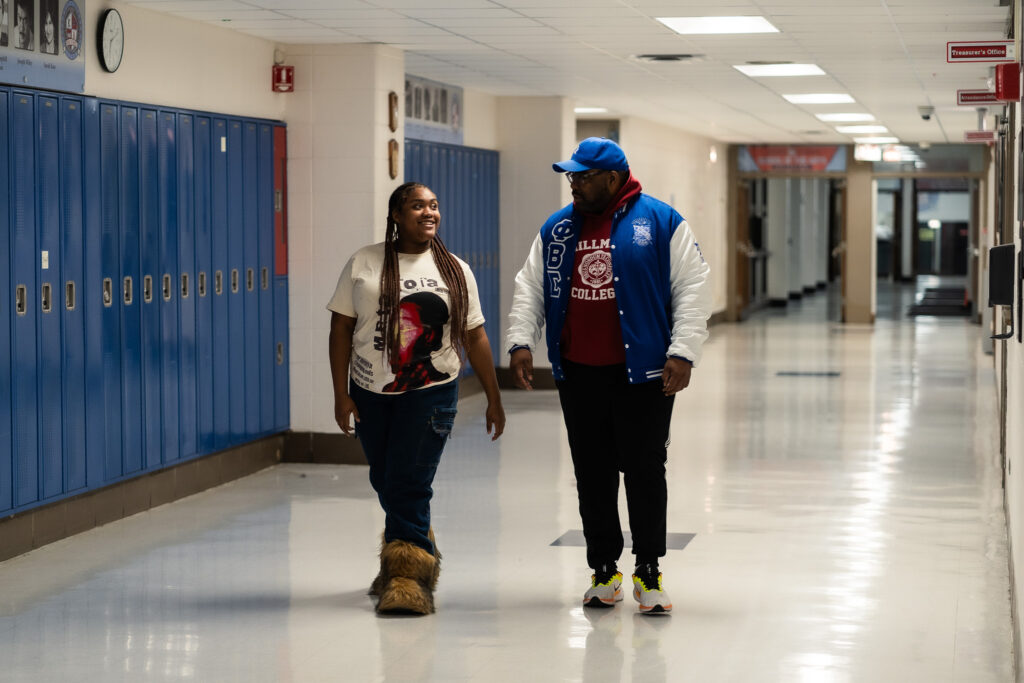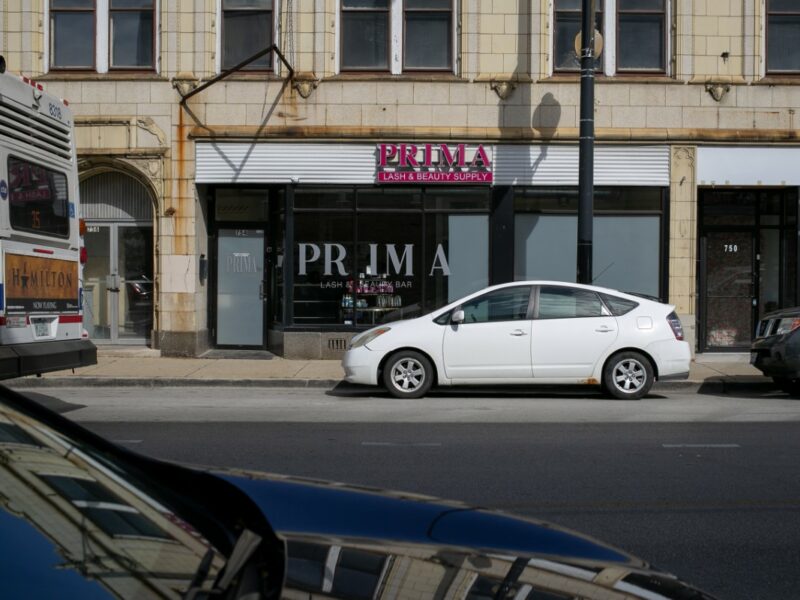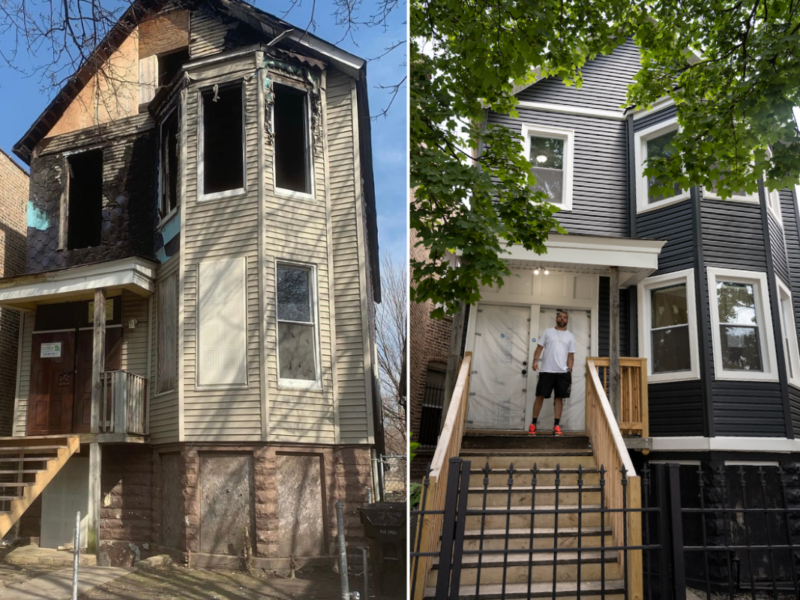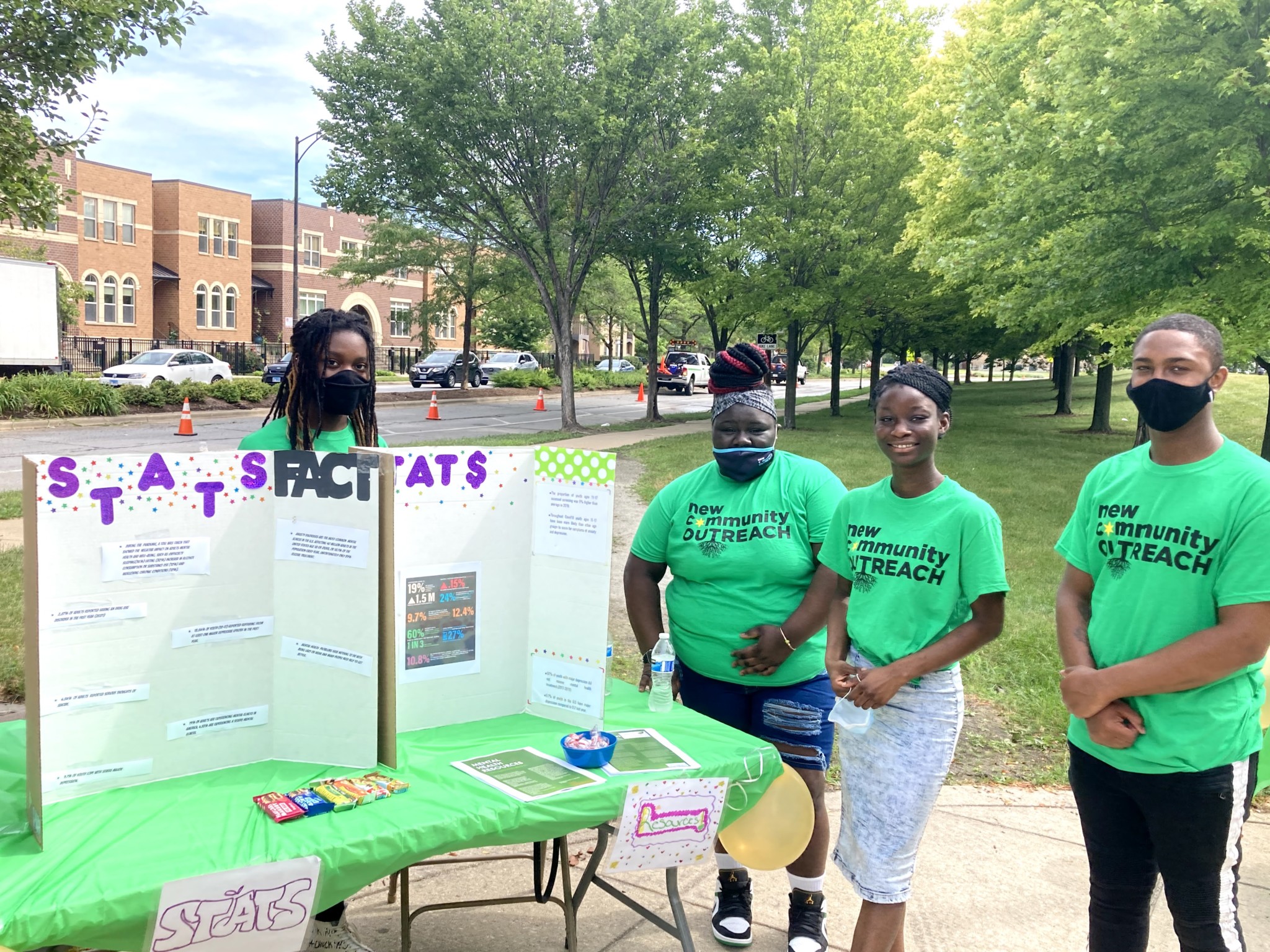When Alycia Kamil was in high school, she would regularly take the bus to the Loop for an art program through After School Matters. As she rode from her home in Auburn Gresham to Gallery 37 at 66 E. Randolph, she saw her world change.
“The travel from Auburn Gresham…to downtown Gallery 37 are just two completely different cities,” Kamil, now twenty-three, told the Weekly. “Just the amount of opportunities that are there—the amount of grocery stores, hospitals, just all the resources that you see just on one bus ride from one side of the city to the other.”
For decades, Chicago’s “tale of two cities,” marked by economic disparities and racial segregation, has disproportionately impacted Black neighborhoods, and many Black folks are leaving the city for better opportunities elsewhere. “Many Black residents, regardless of income level, have left Chicago in the last decade in search of more affordable housing, higher performing schools, and safer spaces,” the preamble of the Chicago Urban League’s 2023 “State of Black Chicago” report, written in collaboration with the Loyola University Institute for Racial Justice.
“What we want to continue to do is come up with data driven recommendations and… solutions to help inform policymakers, politicians, activists, (and) funders on how we can all work together to fix these conditions going on,” Vice President and Executive Director of the Chicago Urban League’s Research and Policy Center Dr. Lionel Kimble told the Weekly.
Over the past forty years Black Chicago has been reeling from the effects of white flight, redlining, and disinvestment. Chicago’s Black population has left in large numbers, decreasing from almost 40 percent of the city in 1980, when it peaked at nearly 1.2 million, to just under 30 percent in 2020. In contrast, Chicago was once considered the “Promised Land” by Black Southerners, a city that offered good-paying jobs, new homes and civil freedoms that were denied by Jim Crow. During the Great Migration, the largest mass movement in American history that began in the 1910s and continued through the 1970s, over 500,000 Black people came to Chicago from the South.
Chicago’s Black population today stands at 787,551, according to the 2020 census analyzed by the Chicago Tribune. Over the last decade, it decreased by 84,738 people, a drop of 10 percent— the second-largest Black population decline of any urban area nationwide, behind Detroit.
As the South Side Black community navigates the realities of today’s disparities, a younger generation of born-and-bred South Siders looks to whether they want to stay in the city. The Weekly spoke with two rising seniors set to graduate high school and college while facing a limited job market, an increasing rent burdened housing market, and crime, among other factors.
Disinvestment of social, economic and political resources takes many forms within communities. From average income to loan approval percentage to education level, the North and South Sides tell two different stories.
During high school, Kamil moved to Woodlawn to attend Kenwood Academy, where she noticed these dynamics first-hand, especially the lack of well-funded youth programming.
“Moving to Woodlawn, where I was close to Hyde Park, you still see those disparities in neighborhoods that are even right next to each other, both on the South Side,” she said. “You definitely see that a lot growing up, but I saw that way more when I got older and I could move around the city.” During this time, rent increases in Woodlawn (which Kamil attributes to the growing presence of the University of Chicago), leading her family to move back to Auburn Gresham.
Regarding income and employment, the Chicago Urban League’s 2023 report identified Black Chicagoans as having the highest rate of poverty (28.3 percent), unemployment (16.1 percent) and lowest median household incomes ($35,965). Comparatively, white Chicagoans have a poverty rate of 10.9 percent, unemployment rate of 9.8 percent and median household income of $82,294.
Despite this, the report notes that the “racial differences in income and unemployment are not as stark as the spatial differences,” presenting maps of per capita income and percent unemployment across the city, with clear concentrations of higher income in the Loop and on the North Side and higher unemployment on the South Side. “The concentration of wealth in certain neighborhoods translates [to] the concentration of opportunities in these same neighborhoods. In other words, the rich will get richer, and the poor will get poorer.”
The Chicago Urban League’s report observed that housing accessibility for Black Chicagoans “bears the costs of generations of systematic racism in the design and planning of the city as well as the housing market that existed since the Great Migration.” White flight from the South and West Sides in the 1960s and subsequent disinvestment from neighborhoods that previously excluded Black people has had detrimental effects: vacancies, rent burden, homeownership, and homelessness. For prospective homeowners, these legacies pose real challenges when considering the housing market combined with education disparities and school closures.
“Think about the school closures that happened in 2013 and how that set off a cycle of disappointment for the lack of investment in students in Chicago. That to me is probably the biggest example of disinvestment,” Kamil said. “We can live in a city where it is normalized for fifty schools to be closed down. What does that say about how our youth are valued in the city?”
“Chicago needs educators who understand what it’s like to be a CPS student,” said Nita Kimble, a senior at Kenwood Academy, aspiring CPS teacher, and daughter of Dr. Kimble. Born and raised in Bronzeville, Kimble felt that many educators did not have a genuine passion for nurturing students that needed care and support. “I’ve had teachers that seem like they’re there just to be there, and then they don’t actually have any regard for me as a student,” she said.
Like Kamil, Kimble points to Chicago’s under-resourced public education system for lacking incentives to attract good teachers to provide quality instruction to students. “I feel like there’s a lot of people who don’t want to be teachers, a lot of people don’t want to go into education because the education system is flawed, or teachers don’t make any money,” she said. “I think it takes more educators to take that step and to be that person to help inspire the next generation.”
In Chicago, 47 percent of Chicago Public Schools have a majority Black student body, despite Black students being 36 percent of CPS students the 2020-21 school year. In 2013, CPS closed fifty schools due to low performance or under enrollment, marking the largest mass public school closures in U.S. history. Over 17,000 students and 1,500 staff were affected, according to a Chalkbeat Chicago report. Twenty-six of the former school buildings remain vacant a decade later.
The Black Exodus report also found multiple factors that impact home values on the South Side. White flight in the 1960s combined with extensive redlining that restricted predominately Black school zoning created disparate areas unfavorable for new families. Black neighborhoods lost 13.6 percent of owner-occupied households throughout the 2010s. A 2023 Crain’s Chicago Business report found that lenders deny Black Chicagoans’ mortgage applications at a higher rate (27 percent) than they do Latinx (20 percent) and white applicants (11 percent), and if approved, Black and Latinx borrowers generally pay more for their loans. Trends in diminished loan approval have impeded other aspiring property owners and businesses seeking to come to the area.
The persistent racial wealth gap and barriers to accessing capital and building savings “are some of the classic things that people who’ve been arguing for reparations have been arguing for hundreds of years,” said Dr. Kimble.
Nita Kimble remembers her first time venturing out of the South Side with her grandmother to Chinatown. Her first time going to the North Side was four years ago for an After School Matters program at Wrigley Field. “I definitely noticed there was a different dynamic,” she said. “It was a lot more cleaner, a lot more put together, a lot more industrial. I know where I’m from there’s a lot of empty lots and there’s grassy patches.”
As she waits to hear back on college acceptances, Kimble said she thinks about how it could be easier to find a part-time job on the North Side of the city to fill her remaining time at Kenwood. “It was a lot of stores, [my friends] talk about how if we lived up there, we would probably be able to get a job because there were so many businesses and I know somebody’s hiring,” she said. Meanwhile in the Bronzeville area Kimble does not see many opportunities. “I’m still having a hard time finding a job. I feel like nowhere is hiring, not even McDonalds, which is crazy.” She added that she’s considered looking for part-time jobs beyond the South Side, but unreliable public transportation is another barrier; her father currently drives her most places.

A UIC study found the jobless rate for Black youth ages twenty to twenty-four was 57 percent in 2021, increasing from 44 percent in 2019.
Fewer employment opportunities that offer a livable wage, increased costs of living in rent-burdened areas, and other challenges faced by young people in the city leave few options. The Chicago Urban League report asserts that crime in Chicago’s Black communities are a manifestation of these barriers. Some young people resort to crime as means of making money. “High rate of crime, particularly violent crime, in Black communities further diminishes the lesser values of these properties as well as deter future investors. High rates of imprisonment in our communities also remove a large portion of potential earners from our communities, thus reducing the income present in our neighborhoods,” the report says. “This exacerbates the financial strain of many Black families in Chicago.”
Beyond jobs, Kimble wants to see Bronzeville offer youth more opportunities to use their free time meaningfully, “more opportunities to do positive things with our time …as opposed to just sitting behind Whole Foods after school doing nothing.”
Kamil is beginning her role working with young people as a staff member at After School Matters, one of the few youth spaces that Kimble mentioned working in her neighborhood. Kamil discussed experiencing grief and burnout in her work leading her to potentially leave the city. She’s uncertain what’s next for the future as someone raised on the South Side and she sees many of the disparities she worked to address reflected in students.
“There is a lack of opportunities and a lack of safe space for youth in the city right now. There are a lot of places that are being closed, a lot of art centers that are being closed. We don’t see a lot of activities that you are genuinely excited for and being invested in, and there are a lot of spaces outside of Chicago that do offer those opportunities, sadly,” she said. “I think it’s a pull that makes people want to leave the city so they can experience stuff that they might not be experiencing in Chicago.”
As a freshman at Kenwood, Kamil got involved with community organizing through grassroots organizations to lead school walkouts, gun violence-prevention events, and art and restorative justice workshops. She graduated in 2019 and dedicated herself to similar organizing to address disparities through advocacy, education and healing, founding social justice platform Undoing our Erasure. Today, she sees the amount of young people wanting to leave the city and questions her work over the years.
“I know a lot of youth who are looking to leave the city after they are done with high school. It’s very sad, but it is just a reality I’ve been noticing,” she said. “Even me who, at twenty-three, is figuring out being in college right now…I wanted to stay in Chicago a few years back, but now I even want to leave the city and do something new.”
Kamil’s story represents one of the many young people born and raised in Chicago who are ultimately questioning their place in the city after working to make it better for all.
Ultimately, Kamil says she is optimistic. “I’m very hopeful that change will happen. I’m a believer and I would love to see that for Chicago,” she said. “But…it is very hard to get over years of losses, years of grief, and still have a hopeful spirit. I still believe that Chicago has enough people power and those people who are working endlessly to make the city a better place for it to happen. I just think naturally people have experienced lots of grief for years, it’s natural for them to feel a little bit hopeless at the end of it all.”
Michael Liptrot is a staff writer at South Side Weekly and Hyde Park Herald.





So interesting, and so discouraging. My first year as a teacher (1965), I was assigned to Wendell Phillips High School. I grew up in Hyde Park — owned & operated by U of C and despite the aura of liberalism and equality and tolerance, it was very very very White. Going to 47th St. or 63rd St. was considered dangerous. After college, I lived on the North Side. The racism was systemic — it was simply part of what was. No one questioned it. It was acceptable. It was permitted. Later, I recognized and challenged it, but with limited success. Bad weather meant moving to LA where racism certainly exists but it is less and is diminishing. When I returned to visit Chicago, I noticed how things are unchanged. I remember that Martin Luther King commented (around 1966) that Chicago was the most segregated city in the country north of the Mason-Dixon Line. This article is discouraging and sad….but it is important to continually & loudly expose the entrenched intolerance and prejudice. Thank you for your efforts.